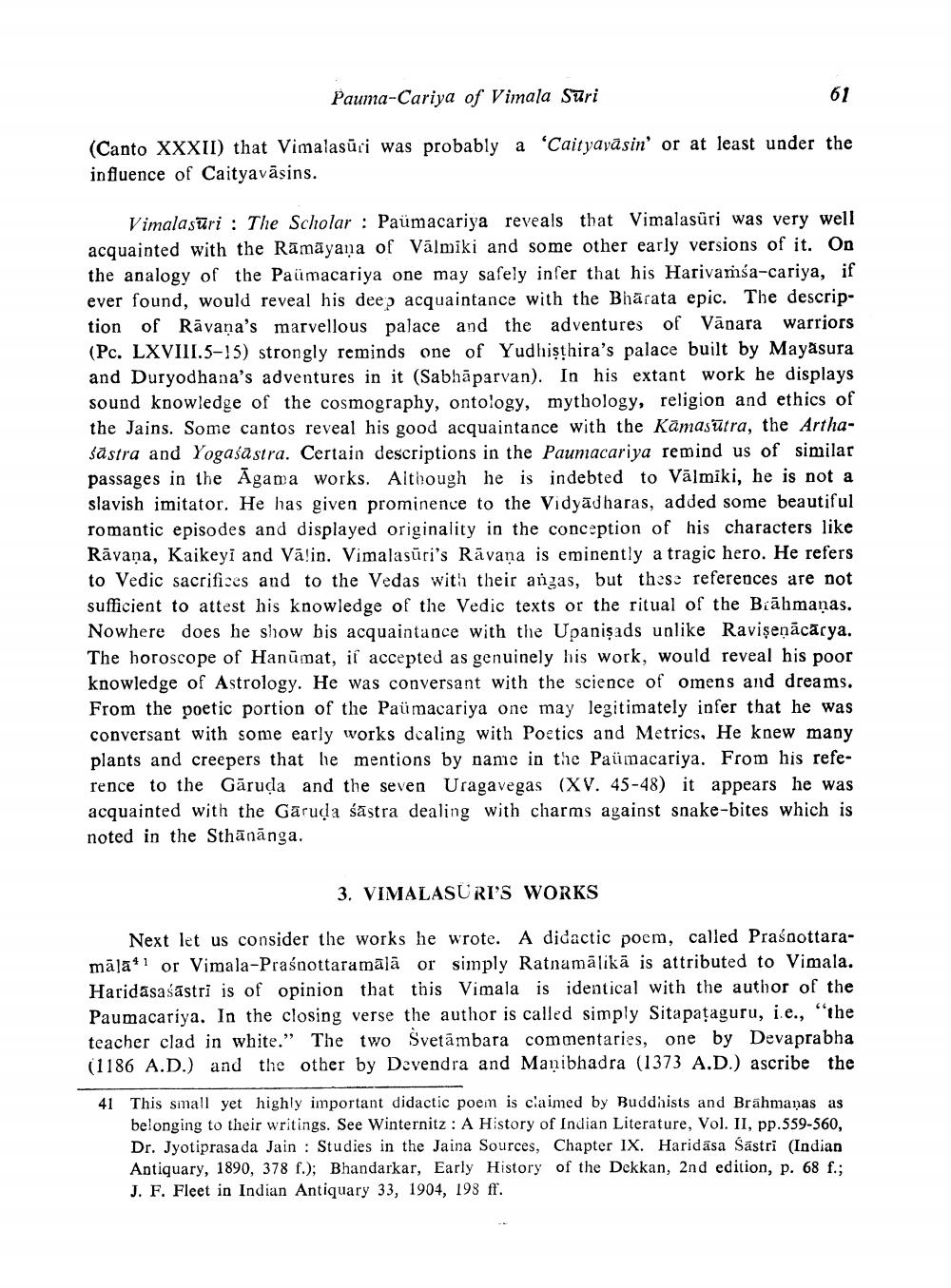________________
Pauma-Cariya of Vimala Sari
(Canto XXXII) that Vimalasūci was probably a 'Caityavāsin' or at least under the influence of Caityavāsins.
Vimala sūri : The Scholar : Paumacariya reveals that Vimalasüri was very well acquainted with the Rāmāyaṇa of Vālmiki and some other early versions of it. On the analogy of the Paümacariya one may safely infer that his Harivamsa-cariya, if ever found, would reveal his deep acquaintance with the Bhärata epic. The description of Rāvana's marvellous palace and the adventures of Vānara warriors (Pc. LXVIII.5-15) strongly reminds one of Yudhisthira's palace built by Mayasura and Duryodhana's adventures in it (Sabhāparvan). In his extant work he displays sound knowledge of the cosmography, ontology, mythology, religion and ethics of the Jains. Some cantos reveal his good acquaintance with the Kamasutra, the Arthasastra and Yogaśāstra. Certain descriptions in the Paumacariya remind us of similar passages in the Agama works. Although he is indebted to Vālmiki, he is not a slavish imitator. He has given prominence to the Vidyadharas, added some beautiful romantic episodes and displayed originality in the conception of his characters like Rāvana, Kaikeyi and Vālin. Vimalasüri's Rāvana is eminently a tragic hero. He refers to Vedic sacrifices and to the Vedas with their angas, but these references are not sufficient to attest his knowledge of the Vedic texts or the ritual of the Brāhmaṇas. Nowhere does he show bis acquaintance with the Upanişads unlike Ravişenācārya. The horoscope of Hanumat, if accepted as genuinely his work, would reveal his poor knowledge of Astrology. He was conversant with the science of omens and dreams. From the poetic portion of the Paümacariya one may legitimately infer that he was conversant with some early works dealing with Poetics and Metrics, He knew many plants and creepers that he mentions by name in the Paümacariya. From his reference to the Gāruda and the seven Uragavegas (XV. 45-48) it appears he was acquainted with the Garuda śāstra dealing with charms against snake-bites which is noted in the Sthānānga.
3. VIMALASURI'S WORKS
Next let us consider the works he wrote. A didactic poem, called Praśnottaramāla'l or Vimala-Praśnottaramālā or simply Ratnamālikā is attributed to Vimala. Haridasasastri is of opinion that this Vimala is identical with the author of the Paumacariya. In the closing verse the author is called simply Sitapataguru, ie., "the teacher clad in white.” The two Svetāmbara commentaries, one by Devaprabha (1186 A.D.) and the other by Devendra and Manibhadra (1373 A.D.) ascribe the
41 This small yet highly important didactic poem is claimed by Buddhists and Brāhmaṇas as
belonging to their writings. See Winternitz : A History of Indian Literature, Vol. II, pp.559-560, Dr. Jyotiprasa da Jain : Studies in the Jaina Sources, Chapter IX. Haridāsa Šāstri (Indian Antiquary, 1890, 378 f.); Bhandarkar, Early History of the Dekkan, 2nd edition, p. 68 f.; J. F. Fleet in Indian Antiquary 33, 1904, 198 ff.




